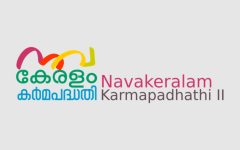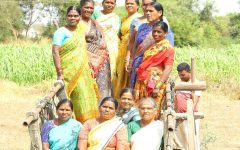Policy Brief on Expansion ofPradhan Mantri Jan Arogya Yojana (PM-JAY)
November 3, 2025 2025-11-03 6:56Policy Brief on Expansion ofPradhan Mantri Jan Arogya Yojana (PM-JAY)

Policy Brief on Expansion ofPradhan Mantri Jan Arogya Yojana (PM-JAY)
By Sneha Singla
INTRODUCTION
The Pradhan Mantri Jan Arogya Yojana (PM-JAY) is a landmark initiative under Ayushman Bharat scheme, with a vision for achieving “Universal Health Coverage.” It offers health insurance coverage up to Rs 5 Lakh per family identified as ‘deprived’ in the SECC (Socio-economic and Caste Census), 2011.
On September 11, 2024, the union cabinet approved a major expansion of the scheme to include all senior citizens aged 70 and above, regardless of their income. This expansion is set to benefit around 4.5 crore families, including 6 crore senior citizens. According to a recent report by NITI Aayog, only around one-fifth of the elderly population (60+) in India is covered by health insurance, and 78% remain without any pension coverage. This significant move to cover the most vulnerable of the non-poor, mitigates the increased vulnerability faced by families of older citizens who must finance healthcare expenses without any support. Further, it is a step towards offering financial protection to the Indian middle class during health emergencies.
The expansion of AB-PMJAY is part of a series of policy initiatives addressing issues of the elderly population. The following charts depict two threads of government policy direction: the first depicts policy action for the elderly and the second shows the path of PM-JAY. They both converge at the 2024 expansion.
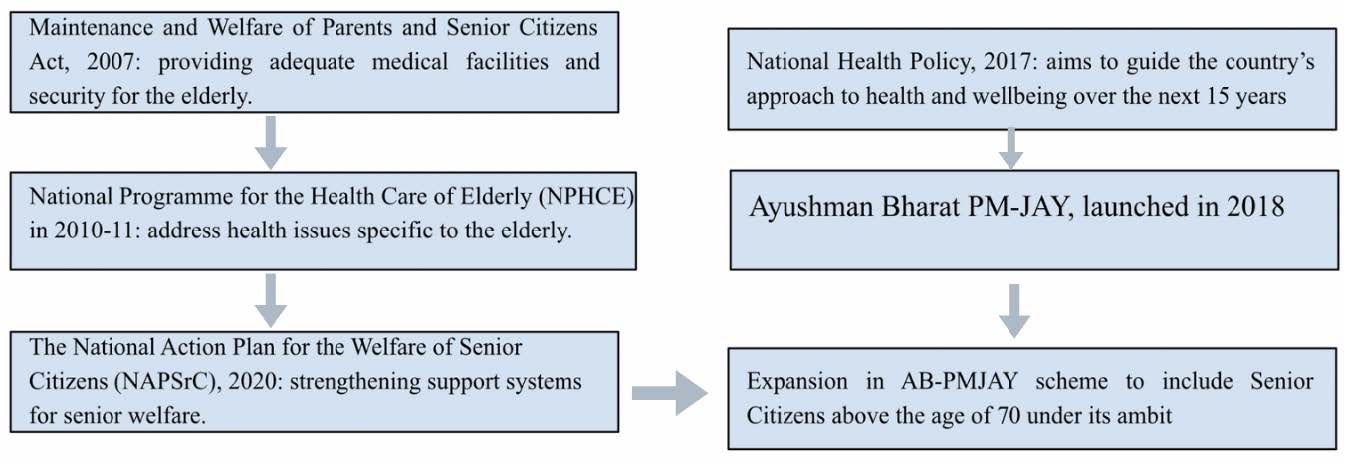
POLICY OVERVIEW
Key Features
| All senior citizens aged 70 years or above are eligible, and will receive a distinct card (Ayushman Vay Vandana cards). Aadhaar-based e-KYC is mandatory for enrollment. |
| Senior citizens who are not part of an existing PM-JAY family coverage will be provided with a cover of up to Rs 5 lakh per year on a family basis. Those in families already covered will receive an additional top-up cover which shall not be shared with family members under 70. |
| Senior citizens availing private health insurance or state insurance schemes are also eligible. |
| Senior citizens who are already benefiting from other public health insurance schemes like the Central Government Health Scheme (CGHS), Ex-Servicemen Contributory Health Scheme (ECHS), or Ayushman Central Armed Police Force (CAPF) have the option to either continue with their current scheme or opt for AB PM-JAY |
Implementation Mechanism
Firstly, implementation involves enrollment of senior citizens. Currently, there are 4 means of enrollment:
| All senior citizens aged 70 years or above are eligible, and will receive a distinct card (Ayushman Vay Vandana cards). Aadhaar-based e-KYC is mandatory for enrollment. |
| Senior citizens who are not part of an existing PM-JAY family coverage will be provided with a cover of up to Rs 5 lakh per year on a family basis. Those in families already covered will receive an additional top-up cover which shall not be shared with family members under 70. |
| Senior citizens availing private health insurance or state insurance schemes are also eligible. |
| Senior citizens who are already benefiting from other public health insurance schemes like the Central Government Health Scheme (CGHS), Ex-Servicemen Contributory Health Scheme (ECHS), or Ayushman Central Armed Police Force (CAPF) have the option to either continue with their current scheme or opt for AB PM-JAY |
- Mobile phone application (Ayushman App)
- Web portal (beneficiary.nha.gov.in)
- Visiting nearby empanelled hospitals or Common Service Centre for creation of cards
- May give a missed call to helpline number 1800-110-770 or call to 24×7 call centre (14555) for any assistance/queries
This occurs simultaneously with enrollment of hospitals. All public hospitals, national institutes run by Ministry of Health & Family Welfare and Institute Of National Importance are deemed empanelled as a part of the healthcare provider network. Hospitals belonging to Employee State Insurance Corporation (ESIC) may also be empanelled based on the bed occupancy ratio parameter.
Private hospitals are empanelled by State Health Agencies (SHA) of respective States based on detailed criteria and process as laid down on the official website. These include:
- Should have at least 10 in patient beds (exemption may be given for single speciality hospital),
- Adequate qualified nursing and medical staff available round the clock,
- Round the clock ambulance facilities and so on.
The budget allocated to AB-PMJAY was Rs.7299 crore for FY 2024-25 and Rs.9406 crore for FY 2025-26. The expansion (to those 70 and above) has been allocated initial funds of Rs 3,437 crores.
Stakeholder Analysis
The primary stakeholders are senior citizens, caregivers and service delivery mechanisms. In India, the 70+ aged population has grown from 2.8% of the Indian population in 2001 to 4.3% in 2021, and is expected to double by 2031. The following mapping shows the major stakeholders:
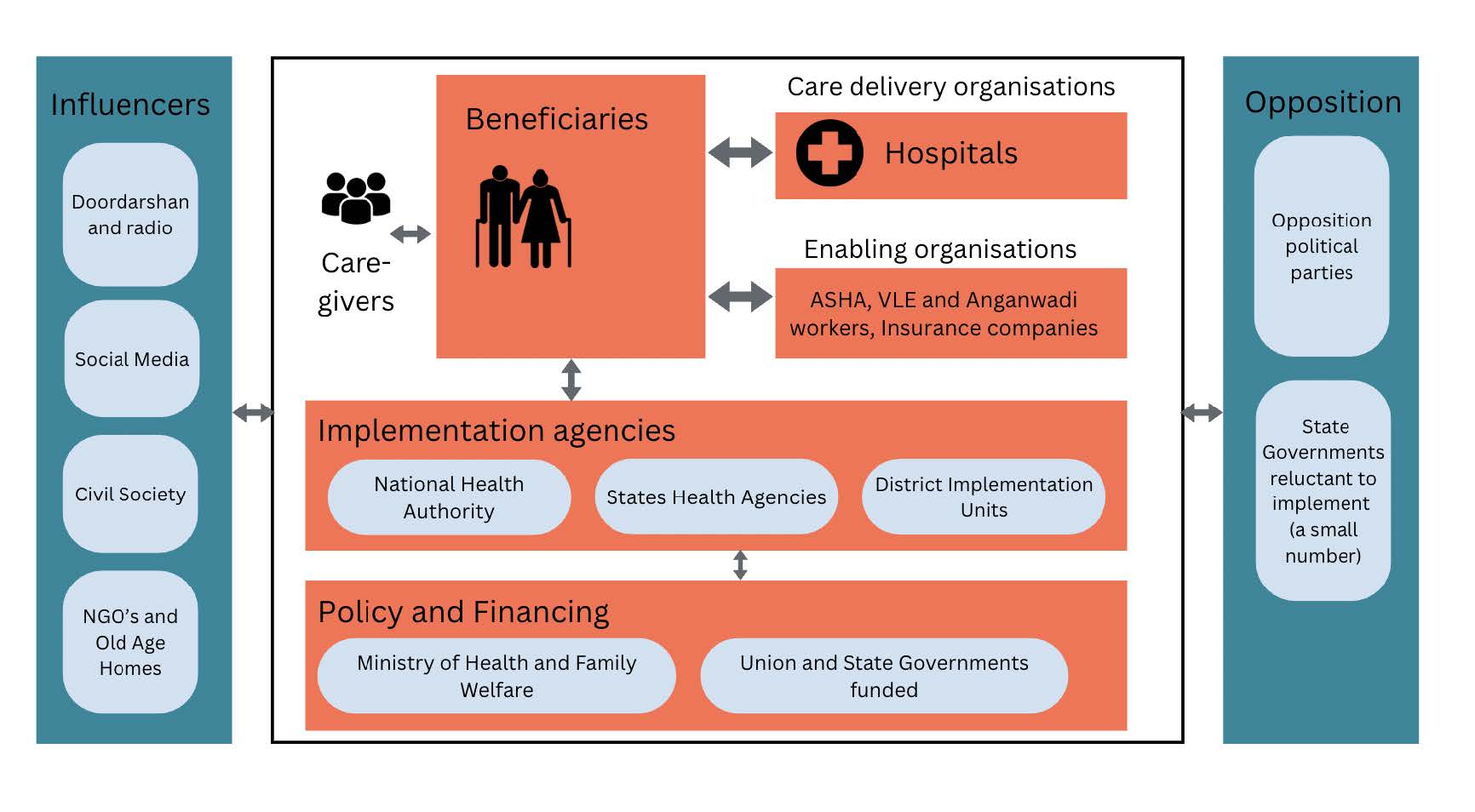
ACHIEVEMENTS AND CHALLENGES
The primary advantage is health inclusivity for the most vulnerable section of the community. As of 06.02.2025, more than 47.2 lakh eligible senior citizens have enrolled for Ayushman Vay Vandana cards. As of 28.01.2025, 1.10 lakh hospital admissions worth Rs 202.96 crore has been authorized for Ayushman Vay Vandana. Yet, many challenges are faced, such as low awareness due to digital literacy barriers, which further increase exposure to frauds. The elderly often exhibit complex medical needs such as dementia and the healthcare system is not geared to handle them.
Further, current data estimates (observed from SECC, 2011 and Niti Aayog Data) centres around the population of 60+. There is inadequate data about the target age group (70+). Therefore, the underwriting of risk and budget requirements cannot be accurate. Currently, the 60-plus already comprises 14% of the over 350 million Ayushman card holders who have accessed the scheme. At the same time, almost one-fourth of all authorised hospital admissions, amounting to 69 million, under the scheme from its inception in 2018, are of patients 60 or above and most of them are from the poor and vulnerable households. The extension of this scheme further enlarges the budget requirements, which must be met with rigorous data driven clarity.
KEY RECOMMENDATIONS
In order to effectively deal with the challenges currently faced, and those that loom ahead, a few steps must be undertaken at both the foundational as well as expansionary levels.
- Firstly, ensure data collection specifically of the target age group in the upcoming census. While currently the age bracket for data collection is 60+, a sub-category of 70+ (those who are beneficiaries of this scheme) must also be included.
- Further, data collection mediums must be strategically implemented at the ground level, specifically in hospitals. Collaboration with private hospitals and international institutes can further give impetus to research relevant to this scheme.
- Third, in order to increase enrollment and engagement, frontline workers, panchayats and NGOs must be leveraged. There are approximately 2.5 million Anganwadi workers and helpers in India. The inclusion of grassroot mechanisms can help create a system wherein schemes reach effectively.
- Next, utilise data highways and AI for better estimation, governance and surveillance.
- Lastly, invest in home based care/ telemedicine to build capacity and reduce hospitalisations. The Indian telemedicine market is growing significantly, with the market size expected to increase from $1.10 billion in 2022 to $5.15 billion by 2030.
CONCLUSION
The PM-JAY under Ayushman Bharat is an ambitious initiative, and extending it to the non-poor is a visionary initiative in safeguarding healthcare of the elderly. It shows scope and possibility for covering Indian middle classes in the long term. While this flagship programme is the largest of its kind in the world, the large-scale implementation also faces multiple hurdles, which must be addressed through clear and data driven policy interventions.
SOURCES
Press Information Bureau. (2024, October 29). PM-JAY Scheme Expanded to Include Senior Citizens Above 70 Years Regardless of Income Criteria. Ministry of Health and Family Welfare, Government of India. Retrieved from https://www.pib.gov.in/PressNoteDetails.aspx?NoteId=153181&ModuleId=3
Ministry of Health and Family Welfare (MoHFW). (2024). Press Information: Expansion of PM-JAY. Government of India. Retrieved from https://mohfw.gov.in/?q=press-info/7742
National Health Authority (NHA). (n.d.). PM-JAY Hospital Empanelment Q&A. Ayushman Bharat – Pradhan Mantri Jan Arogya Yojana. Retrieved from https://pmjay.gov.in/hospital/empanelment-qa
Observer Research Foundation (ORF). (2024). PM-JAY Cover for All Elderly Indians Irrespective of Income: A Major Step Towards Universal Health Care. Retrieved from https://www.orfonline.org/expert-speak/pmjay-cover-for-all-elderly-indians-irrespective-of-income-a-major-step-towards-universal-health-care
NITI Aayog. (2024, February). Senior Care Reforms in India. Government of India. Retrieved from https://www.niti.gov.in/sites/default/files/2024-02/Senior%20Care%20Reforms%20in%20India%20FINAL%20FOR%20WEBSITE_compressed.pdf
Lok Sabha Secretariat. (2024). Response to Parliament Question AU125. Sansad Q&A Portal. Retrieved from https://sansad.in/getFile/loksabhaquestions/annex/1715/AU125.pdf?source=pqals
Sneha is a second year undergraduate student at Lady Shri Ram college, pursuing an honours in Political Science with a minor in Economics.
